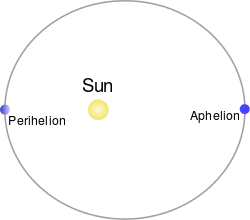Perihelion and aphelion
The perihelion is the point in the orbit of a celestial body where it is nearest to its orbital focus, generally a star. It is the opposite of aphelion, which is the point in the orbit where the celestial body is farthest from its focus.[1]
The word "perihelion" stems from the Ancient Greek words "peri", meaning "near", and "helios", meaning "the Sun". "Aphelion" derives from the preposition "apo", meaning "away, off, apart". (The similar words "perigee" and "apogee" refer to the nearest and furthest points in some object's orbit around the Earth.)
According to Kepler's first law of planetary motion, all planets, comets, and asteroids in the Solar System have approximately elliptical orbits around the Sun.[2] (It is only approximate because the ellipse the body traces in any single orbit does not end exactly where it begins, due to precession.) Hence, an orbiting body has a closest and a farthest point from its parent object, that is, a perihelion and an aphelion. Each extreme is known as an apsis. Orbital eccentricity measures the flatness (departure from a perfect circle) of the orbit.
Application to Earth
Earth is about 147.1 milion kilometers (91.4 million miles) from the Sun at perihelion around January 3, in contrast to about 152.1 million kilometers (94.5 million miles) at aphelion around July 4 — a difference of about 5.0 million kilometers (3.1 million miles). (These dates change over time due to precession and other orbital factors, which follow cyclical patterns known as Milankovitch cycles. For a table of these dates for various years, see Apsis.)
Because of the increased distance at aphelion, only 93.55% of the solar radiation from the Sun falls on a given area of land as does at perihelion. However, this fluctuation does not account for the seasons,[3] as it is summer in the northern hemisphere when it is winter in the southern hemisphere and vice versa. Instead, seasons result from the tilt of Earth's axis, which is 23.4 degrees away from perpendicular to the plane of Earth's orbit around the sun. Winter falls on the hemisphere where sunlight strikes least directly, and summer falls where sunlight strikes most directly, regardless of the Earth's distance from the Sun.
In the northern hemisphere, summer occurs at the same time as aphelion. Despite this, there are larger land masses in the northern hemisphere, which are easier to heat than the seas. Consequently, summers are 2.3 °C (4 °F) warmer in the northern hemisphere than in the southern hemisphere under similar conditions.[4]
See also
References
- ↑ "Perihelion and Aphelion". National Earth Science Teachers Association (NESTA). Retrieved 2015-09-19.
- ↑ "Introductory Astronomy: Ellipses". Washington State University.
- ↑ "Solar System Exploration: Science & Technology: Science Features: Weather, Weather, Everywhere?". NASA. Retrieved 2015-09-19.
- ↑ "Earth at Aphelion". Space Weather. July 2008. Retrieved 7 July 2015.
External links
- Dates and times of Earth's perihelion and aphelion, 2000–2025 from the United States Naval Observatory
